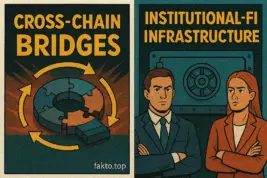Cross-Chain Bridge Architectures
Inside Cross-Chain Bridge Design: Models, Risks, and Trade-Off
Native, Light-Client, Liquidity & Intent-Based Models Compared
Cross-chain bridges are no longer just technical plumbing—they’re strategic infrastructure. For funds, DAOs, and arbitrage desks, the way assets move across chains defines latency, MEV exposure, and even regulatory posture.
This isn’t a beginner’s guide. It’s a deep dive into how different bridge architectures behave under pressure, where they break, and how they might evolve. I’ll be honest: some areas are still murky. For example, I’m not fully convinced that intent-based routing can scale without introducing new centralization vectors.

But I’ll walk through the trade-offs, ask the hard questions, and offer grounded recommendations. If you’re managing real capital, this is the kind of analysis that should shape your bridge strategy.
Bridge Architecture Comparison: What Actually Matters
Let’s start with the basics—but go deeper than the usual surface-level taxonomy. There are four dominant architectural models in cross-chain bridging: native, light-client-based, liquidity network, and intent-based. Each has its own assumptions about trust, latency, and composability. Native bridges rely on direct protocol-level integration, often between L1 and L2 (think Ethereum ↔ Arbitrum).
Light-client bridges use cryptographic verification—SPV, zk-proofs, or optimistic rollups—to validate state across chains. Liquidity networks route assets through pools, often abstracting away the underlying chains. Intent-based systems flip the model: users specify outcomes, and the protocol finds the optimal route. But here’s the catch—none of these models are perfect. Native bridges are fast but brittle.
Light-clients are secure but slow. Liquidity networks are flexible but opaque. Intent-based systems are promising but unproven at scale. So what’s the right choice? It depends on your risk tolerance, latency needs, and governance model.
| Architecture | Trust Model | Latency | Capital Efficiency | MEV Resistance |
|---|---|---|---|---|
| Native | Protocol-level | Low | High | Low |
| Light-client | Cryptographic | Medium–High | Medium | High |
| Liquidity Network | Delegated LPs | Low | Medium–High | Low |
| Intent-based | Execution abstraction | Variable | Potentially high | Potentially high |
Recent Exploit Vectors: What’s Actually Breaking
Let’s be blunt: bridges are still the most exploited surface in DeFi. And it’s not just smart contract bugs—it’s systemic design flaws. Oracle manipulation remains a top threat, especially in liquidity-based bridges where price feeds determine routing. Validator collusion is another under-discussed risk. In light-client bridges, if a quorum of validators goes rogue, the entire verification layer collapses. Liquidity routing exploits are more subtle but equally dangerous.
Attackers manipulate slippage, reroute liquidity through compromised pools, or exploit fallback logic. I’m still trying to wrap my head around how fallback routing interacts with intent-based execution—there’s a risk that abstraction layers obscure critical failure points. Should protocols expose routing logic to users? Or is that just UX noise? I lean toward transparency, but it’s a trade-off.

Bottom line: every bridge architecture has its own unique attack surface. If you’re deploying capital, you need to understand not just how bridges work—but how they fail.
| Exploit Type | Target Architecture | Mechanism | Mitigation Strategy |
|---|---|---|---|
| Oracle Manipulation | Liquidity Network | Fake price feeds, TWAP distortion | Multi-oracle aggregation, circuit breakers |
| Validator Collusion | Light-client | Quorum override, false state proofs | MPC, TEE, slashing conditions |
| Liquidity Routing Exploit | Intent-based | Slippage abuse, fallback hijack | Route transparency, execution delay buffers |
Looking Ahead: AI Routing, MPC, and Intent-Centric Liquidity
This is where things get interesting—and a bit speculative. AI-based routing is already being tested in protocols like SUAVE and LayerZero V2. The idea is simple: let an agent optimize for latency, MEV resistance, and fee efficiency in real time. But I’m cautious. AI routing introduces new risks—opaque decision-making, adversarial manipulation, and centralization creep. MPC (multi-party computation) and TEE (trusted execution environments) are more mature. They’re already being used in custody-grade bridges like Axelar and Wormhole Guardians.
Expanding the role of intent-centric protocols also raises questions about user verification and trust layers. In practice, routing efficiency alone cannot solve the issue of fragmented identities across networks, which is why the development of portable cross-chain identity solutions is becoming so crucial. The interplay between liquidity protocols and identity frameworks shows how reputation can reinforce transaction security. For example, if wallets carried verifiable credentials, AI-based routing could adapt not only to fees and latency but also to the trustworthiness of counterparties. Such convergence hints at a future where bridging isn’t just technical, but also deeply tied to the persistence of digital identity.
Intent-centric protocols are the wild card. Instead of specifying routes, users define outcomes—“I want USDC on Arbitrum”—and the protocol handles the rest. It’s elegant, but also abstract. Can we audit intent execution? Can we simulate failure modes? I’m not sure yet. But I do believe this is the direction we’re heading. The future of bridging isn’t just faster or cheaper—it’s smarter, safer, and more composable.
Institutional Liquidity and Regulatory Friction: What Funds Actually Face
Let’s talk about the elephant in the room: institutional liquidity doesn’t flow freely across chains. It’s gated by compliance, custody, and reputational risk. Bridges that look slick on paper often break down when you introduce KYC, audit trails, and counterparty accountability. Funds using Fireblocks or Anchorage can’t just plug into any liquidity network—they need MPC-secured routing, TEE-based verification, and fallback logic that’s auditable.

MiCA in Europe and SEC pressure in the U.S. are already shaping bridge design. Custody-grade bridges like Axelar and Wormhole Guardians are adapting, but intent-based protocols still raise eyebrows. Who signs the transaction? Who verifies the route? If you’re managing LP capital or DAO treasuries, you need to ask: can this bridge survive a regulatory subpoena? Can it produce a clean audit trail? I’m not saying intent-based systems are off-limits—but they need institutional wrappers.
Maybe that’s where hybrid models come in: intent-routing on the frontend, MPC custody on the backend. It’s not elegant, but it’s survivable.
Efficiency Metrics: Latency, Capital, and MEV Exposure
Efficiency isn’t just about speed—it’s about execution integrity. Latency affects arbitrage viability, slippage, and user experience. Capital efficiency determines how much liquidity you need to lock up to move assets. MEV resistance is the silent killer—if your bridge leaks alpha to sandwich bots or frontrunners, you’re subsidizing attackers. Let’s break it down. Native bridges are fast but leak MEV like a sieve.
| Metric | Why It Matters | Real-World Impact | How to Measure |
|---|---|---|---|
| Latency (Tx Finality) | Defines speed of asset movement | Arbitrage viability, slippage risk | Seconds from initiation to confirmation |
| Capital Efficiency | Liquidity required to support volume | Lock-up cost, idle capital drag | TVL vs. throughput ratio |
| MEV Resistance | Protects against frontrunning & sandwich attacks | Preserves execution integrity | Delta between expected vs. actual execution |
| Retry Logic | Handles failed or delayed transfers | Reduces stuck funds, improves UX | Presence of fallback + retry mechanism |
| Route Transparency | Exposes routing decisions to users | Improves auditability, reduces blind trust | Visible route path + fee breakdown |
Light-client bridges are slow but secure. Liquidity networks are fast and flexible, but vulnerable to oracle games. Intent-based systems promise MEV-resistance—but only if routing is transparent and execution is atomic. I still wonder: should bridges publish latency benchmarks? Should funds demand MEV audits before integrating? Probably yes. If you’re running cross-chain arbitrage, you need sub-second latency and predictable finality.
If you’re a DAO, you need capital efficiency and slippage protection. And if you’re a fund, you need MEV-resistance baked into the routing logic—not bolted on as an afterthought.
Institutional Liquidity and Regulatory Friction
Let’s get tactical. If you’re a fund deploying across chains, prioritize bridges with MPC custody, transparent routing, and fallback logic. Axelar, LayerZero V2, and Wormhole Guardians are worth watching. If you’re a DAO managing treasury flows, avoid bridges with centralized validator sets or opaque liquidity routing.

Look for light-client verification or hybrid intent models. If you’re an arbitrageur, latency is king. Monitor bridge finality, retry logic, and fee structures in real time. And here’s a thought: maybe it’s time for bridges to offer SLAs—service-level agreements—for latency, uptime, and MEV exposure. That’s how you build trust. That’s how you attract institutional capital.
And that’s how you survive the next exploit wave. I’ll say it again: bridges aren’t just infrastructure. They’re strategic assets. Treat them accordingly.
Bridges as Strategic Infrastructure: Beyond the Tech Stack
Let’s be real—most bridge discussions still sound like protocol documentation. But if you’re managing real capital, you don’t care just about how a bridge works. You care about how it behaves under stress, how it integrates with custody, and whether it leaks alpha. Bridges are no longer just technical middleware.
They’re strategic infrastructure. They define how fast you can move liquidity, how much MEV you bleed, and whether your compliance team loses sleep. I’ve seen funds treat bridges like interchangeable pipes—and get burned. The truth is, architecture matters. And so does governance, fallback logic, and even UX. Especially UX.
Because when routing fails, it’s not just a technical issue—it’s a reputational one.
Intent-Based Routing: Elegant, But Still a Black Box?
I’ll admit—I’m intrigued by intent-based protocols. The idea that users specify outcomes (“give me USDC on Arbitrum”) and let the system optimize the route is powerful.
It abstracts complexity, reduces friction, and opens the door to AI-driven liquidity flows. But I’m also cautious. Who verifies the route? Who signs the transaction? What happens if the fallback fails? These aren’t just theoretical questions—they’re operational risks.

I’ve seen intent engines route through compromised pools or fail silently when latency spikes. That’s not acceptable for funds or DAOs. So here’s my take: intent-based routing is the future, but only if it’s auditable, transparent, and composable.
Otherwise, it’s just another black box with a slick UI.
AI Routing: Optimization or Obfuscation?
AI routing sounds sexy. Real-time optimization across chains, fee structures, and MEV exposure? Yes, please. But let’s not get ahead of ourselves. AI introduces new risks—opaque logic, adversarial manipulation, and centralization creep. If your routing engine is a black box, how do you audit it? How do you simulate failure modes? I’ve seen early prototypes that look promising, but I’m still waiting for a model that balances performance with explainability.
Maybe the answer is hybrid: AI suggests routes, but human governance approves them. Or maybe we need SLAs—service-level agreements—for routing integrity. Either way, AI routing isn’t just a tech upgrade. It’s a governance challenge. And we need to treat it as such.
MPC and TEE: Institutional-Grade Security, Real-World Friction
Multi-party computation (MPC) and trusted execution environments (TEE) are becoming standard in custody-grade bridges. Axelar, Wormhole Guardians, and even LayerZero are integrating these technologies to secure validator logic and transaction signing. That’s good news for funds. MPC reduces single-point-of-failure risk. TEE protects against validator collusion. But there’s friction.
| Technology | Security Strength | Operational Friction | Institutional Fit | Key Limitations |
|---|---|---|---|---|
| MPC (Multi-Party Computation) | High — eliminates single point of failure | Medium — requires coordination across parties | Strong — used by Fireblocks, Axelar, Anchorage | Complex setup, slower signing, audit challenges |
| TEE (Trusted Execution Environment) | High — hardware-level isolation | Low–Medium — depends on infrastructure | Moderate — Wormhole Guardians, LayerZero V2 | Jurisdictional risk, hardware trust assumptions |
| Hybrid (MPC + TEE) | Very High — layered security model | High — integration complexity | Emerging — ideal for regulated custody | Latency, cost, governance overhead |
MPC setups are complex, slow to deploy, and hard to audit. TEE introduces hardware dependencies and jurisdictional concerns. I’ve seen funds hesitate to integrate bridges with TEE because of compliance uncertainty. So here’s the trade-off: you get security, but you pay in agility. And in fast-moving markets, that’s a cost.
The question is—can we build MPC/TEE bridges that are plug-and-play? If we can, institutional adoption will explode.
Final Thoughts: Bridges Need to Grow Up
We’re past the point where bridges can be treated like experimental tech. They’re core infrastructure. They move billions. They define user experience. And they’re still too fragile. If you’re building, investing, or deploying across chains, you need to treat bridges like strategic assets.
That means demanding audits, SLAs, fallback logic, and governance transparency. It means asking hard questions about routing, latency, and MEV exposure. And it means pushing the ecosystem toward composability, not just speed. I’ll say it again: bridges aren’t just technical. They’re political, economic, and operational. And if we want DeFi to scale, they need to grow up.
If you’ve already wrapped your head around bridging basics, token swaps, and multichain flows — and you’re ready to dive into validator logic, MEV risks, and routing complexity — check out bridge architecture guide to understand the infrastructure powering institutional-grade liquidity and multichain execution.
Regulation and Institutionalization
Let’s be blunt: jurisdictional fragmentation is one of the biggest headaches for bridges in 2025. The EU’s MiCA framework pushes hard on transparency and reporting, the U.S. SEC is tightening its grip, and Asia is split between sandbox-friendly regimes and heavy oversight. The elephant in the room is that bridges can’t ignore these rules anymore. To survive, many are shifting toward hybrid models—MPC/TEE validators for auditable flows, with the rest staying decentralized for composability. It’s messy, but it’s the only way to satisfy both regulators and users.
Sanctions and blacklist logic make things even murkier. If a bridge bakes in OFAC-style filtering, is it still decentralized—or just a bank with a slick UI? That’s not a thought experiment. For funds and DAOs moving serious capital, regulatory alignment can be the difference between smooth liquidity and assets frozen mid-bridge. Censorship risk isn’t theoretical; it’s operational reality.
And here’s the unresolved dilemma: if a DAO governs a bridge and that bridge is exploited, who takes the subpoena? Can regulators go after pseudonymous token holders? Institutional players already smell the risk, and they’re demanding governance wrappers—foundations, custodial partners, even insurance—to reduce liability.
Until that happens, many funds will treat pure “code is law” bridges as radioactive, no matter how elegant the architecture looks on paper.
Disclaimer
This article is intended for informational and analytical purposes only. It does not constitute financial, investment, legal, or tax advice. The views expressed herein reflect current industry observations and strategic considerations relevant to decentralized finance professionals, and may evolve as technologies and regulations change.
Readers are encouraged to conduct their own due diligence (DYOR) and consult qualified advisors before making decisions involving cross-chain infrastructure, asset deployment, or protocol integration. The author assumes no responsibility for losses or liabilities arising from the use or interpretation of this content.
